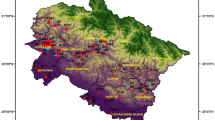Abstract
The objective of this study was to determine the bacterial contaminations in drinking water in Nyala city, South Darfur, Sudan with special reference to the internally displaced people camps (IDPs). Two hundred and forty water samples from different sites and sources including bore holes, hand pumps, dug wells, water points, water reservoir and household storage containers were collected in 2009. The most probable number method was used to detect and count the total coliform, faecal coliform and faecal enterococci. Results revealed that the three indicators bacteria were abundant in all sources except water points. Percentages of the three indicators bacteria count above the permissible limits for drinking water in all samples were 46.4% total coliform, 45.2% faecal coliform and 25.4% faecal enterococci whereas the highest count of the indicators bacteria observed was 1,600 U/100 ml water. Enteric bacteria isolated were Escherichia coli (22.5%), Enterococcus faecalis (20.42%), Klebsiella (15.00%), Citrobacter (2.1%) and Enterobacter (3.33%). The highest contamination of water sources was observed in household storage containers (20%) followed by boreholes (11.25%), reservoirs (6.24%), hand pumps (5.42%) and dug wells (2.49%). Contamination varied from season to season with the highest level in autumn (18.33%) followed by winter (13.75%) and summer (13.32%), respectively. All sources of water in IDP camps except water points were contaminated. Data suggested the importance of greater attention for household contamination, environmental sanitation control and the raise of awareness about water contamination.
Similar content being viewed by others
References
Akoachere, J. F., Oben, P. M., Mbivnjo, B. S., Nkwelang, G., & Ndip, R. N. (2008). Bacterial indicators of pollution of the Douala Lagoon Cameroon: Public health implication. African Health Sciences, 8(2), 85–89.
APHA (1998). American public health association: Standard methods for examination of water and wastewater (20th Ed.). Washington, DC: American Public Health Association.
Djuikom, E., Njine, T., Nola, M., Sikati, V., & Jugnia, B. (2006). Microbiological water quality of the Mfoundi river watershed at Yaoundé, Cameroon, as inferred from indicator bacteria of faecal contamination. Environmental Monitoring and assessment, 122, 171–183.
Duse, A. G., Silva, M. P., & Zietsman, I. (2003). Coping with hygiene in South Africa, a water scarce country. International Journal of Environmental Health Research, 13, 95–105.
Ferguson, C. M., Coote, B. G., Ashbolt, N. J., & Stevenson, I. M. (1996). Relationships between indicators, pathogens and water quality in an estuarine system. Water Research, 30(9), 2045–2054.
Fewtrell, L., & Bartram, J. (Eds.) (2001). Water quality: Guidelines, standards andhealth. London, UK: IWA Publishing.
Gagnon, G. A., Rand, J. L., Leary, K. C., Rygel, A. C., Chauret, C., & Andrews, R. C. (2005). Disinfection efficacy of chlorite and chlorine dioxide in drinking water biofilms. Water Research, 39, 1809–1817.
Hammad, Z. H., & Dirar, H. A. (1982). Microbiological examination of Sebeel water. Applied and Environmental Microbiology, 43(6), 1238–1243.
Jain, C. K., Bandyopadhyay, A., & Bhadra, A. (2009). Assessment of ground water quality for drinking purpose, District Nainital Utt arakhand, India. Environmental Monitoring and Assessment. doi:10.1007/s10661-009-1031-5.
Kistemann, T., Classen, T., Koch, C., Dangendorf, F., Fischeder, R., Gebel, J., et al. (2002). Microbial load of drinking water reservoir tributaries during extreme rainfall and runoff. Applied and Environmental Microbiology, 65(5), 251–264.
Laukova, A., & Juris, P. (1997). Distribution and characterization of Enterococcus species in municipal sewage. Microbiology, 89(359), 73–81.
Mazengia, M. S., Chidavaen, Z. M., & Bradley, M. (2002). Effective and culturally acceptable water storage in Zimbabwe: Maintaining the quality of water abstracted from upgraded family wells. Journal of Environmental Health, 64, 15–18.
Momba, M. N. B., & Notshe, T. L. (2003). The microbiological quality of ground water after long storage in house hold container in a rural community of South Africa. Journal of water supply Research and Technique AQUA, 52, 67–77.
Ologe, J. O. (1989). Household water in rural Kwara. In water engineering and development in Africa: Proceedings of the 15th WEDC conference. Loughborough.
Sanderson, M. W., Sargeant, J. M., Renter, D. G., Griffin, D. D., & Smith, R. A. (2005). Factors associated with the presence of coliforms in the feed and water of feedlot cattle. Applied and Environmental Microbiology, 71(10), 6026–6032.
Stevens, M., Ashbolt, N., & Cunliffe, D. (Eds.) (2003). Review of coliforms as microbial indicators of drinking water quality—recommendations to change the use of coliforms as microbial indicators of drinking water quality (pp. 1–42). Australia: NHMRC, Biotext Pty Ltd, Canberra.
WHO (2003). Emerging issues in water and infectious disease. Geneva: World Health Organization.
World Health Organization (2004). Guidelines for drinking water quality (Vol. 1, 3rd Ed.). Geneva: Recommendation, WHO.
Wright, J., Gundry, S., & Conroy, R. (2004). House hold drinking water in Developing countries: A systematic review of microbiological contamination between source and point of use. Tropical Medicine and International Health, 9(1), 106–117.
Author information
Authors and Affiliations
Corresponding author
Rights and permissions
About this article
Cite this article
Abdelrahman, A.A., Eltahir, Y.M. Bacteriological quality of drinking water in Nyala, South Darfur, Sudan. Environ Monit Assess 175, 37–43 (2011). https://doi.org/10.1007/s10661-010-1491-7
Received:
Accepted:
Published:
Issue Date:
DOI: https://doi.org/10.1007/s10661-010-1491-7




